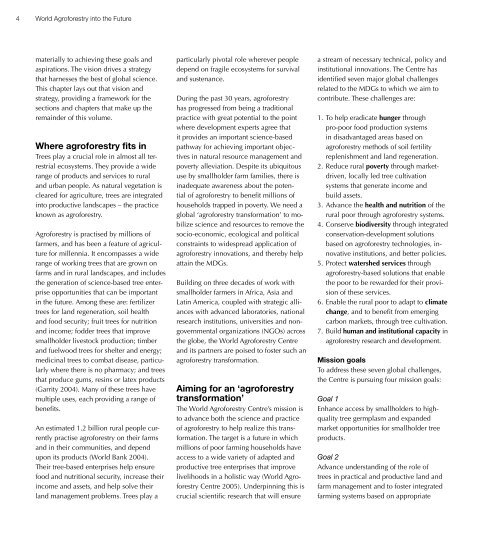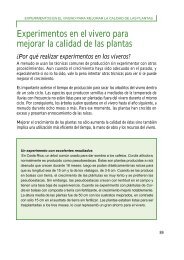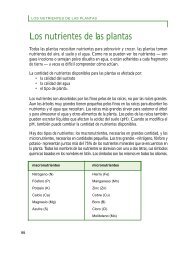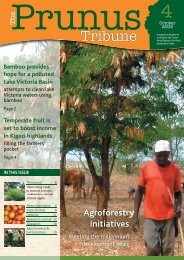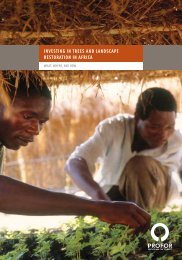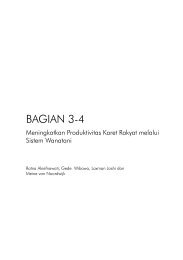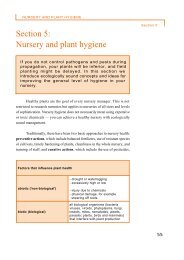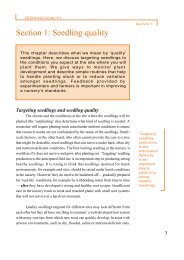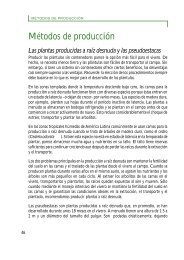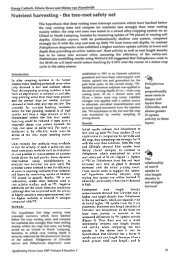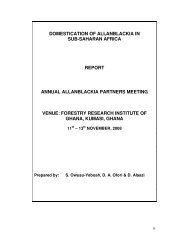Download as a PDF - World Agroforestry Centre
Download as a PDF - World Agroforestry Centre
Download as a PDF - World Agroforestry Centre
Create successful ePaper yourself
Turn your PDF publications into a flip-book with our unique Google optimized e-Paper software.
4<br />
<strong>World</strong> <strong>Agroforestry</strong> into the Future<br />
materially to achieving these goals and<br />
<strong>as</strong>pirations. The vision drives a strategy<br />
that harnesses the best of global science.<br />
This chapter lays out that vision and<br />
strategy, providing a framework for the<br />
sections and chapters that make up the<br />
remainder of this volume.<br />
Where agroforestry fits in<br />
Trees play a crucial role in almost all terrestrial<br />
ecosystems. They provide a wide<br />
range of products and services to rural<br />
and urban people. As natural vegetation is<br />
cleared for agriculture, trees are integrated<br />
into productive landscapes – the practice<br />
known <strong>as</strong> agroforestry.<br />
<strong>Agroforestry</strong> is practised by millions of<br />
farmers, and h<strong>as</strong> been a feature of agriculture<br />
for millennia. It encomp<strong>as</strong>ses a wide<br />
range of working trees that are grown on<br />
farms and in rural landscapes, and includes<br />
the generation of science-b<strong>as</strong>ed tree enterprise<br />
opportunities that can be important<br />
in the future. Among these are: fertilizer<br />
trees for land regeneration, soil health<br />
and food security; fruit trees for nutrition<br />
and income; fodder trees that improve<br />
smallholder livestock production; timber<br />
and fuelwood trees for shelter and energy;<br />
medicinal trees to combat dise<strong>as</strong>e, particularly<br />
where there is no pharmacy; and trees<br />
that produce gums, resins or latex products<br />
(Garrity 2004). Many of these trees have<br />
multiple uses, each providing a range of<br />
benefits.<br />
An estimated 1.2 billion rural people currently<br />
practise agroforestry on their farms<br />
and in their communities, and depend<br />
upon its products (<strong>World</strong> Bank 2004).<br />
Their tree-b<strong>as</strong>ed enterprises help ensure<br />
food and nutritional security, incre<strong>as</strong>e their<br />
income and <strong>as</strong>sets, and help solve their<br />
land management problems. Trees play a<br />
particularly pivotal role wherever people<br />
depend on fragile ecosystems for survival<br />
and sustenance.<br />
During the p<strong>as</strong>t 30 years, agroforestry<br />
h<strong>as</strong> progressed from being a traditional<br />
practice with great potential to the point<br />
where development experts agree that<br />
it provides an important science-b<strong>as</strong>ed<br />
pathway for achieving important objectives<br />
in natural resource management and<br />
poverty alleviation. Despite its ubiquitous<br />
use by smallholder farm families, there is<br />
inadequate awareness about the potential<br />
of agroforestry to benefit millions of<br />
households trapped in poverty. We need a<br />
global ‘agroforestry transformation’ to mobilize<br />
science and resources to remove the<br />
socio-economic, ecological and political<br />
constraints to widespread application of<br />
agroforestry innovations, and thereby help<br />
attain the MDGs.<br />
Building on three decades of work with<br />
smallholder farmers in Africa, Asia and<br />
Latin America, coupled with strategic alliances<br />
with advanced laboratories, national<br />
research institutions, universities and nongovernmental<br />
organizations (NGOs) across<br />
the globe, the <strong>World</strong> <strong>Agroforestry</strong> <strong>Centre</strong><br />
and its partners are poised to foster such an<br />
agroforestry transformation.<br />
Aiming for an ‘agroforestry<br />
transformation’<br />
The <strong>World</strong> <strong>Agroforestry</strong> <strong>Centre</strong>’s mission is<br />
to advance both the science and practice<br />
of agroforestry to help realize this transformation.<br />
The target is a future in which<br />
millions of poor farming households have<br />
access to a wide variety of adapted and<br />
productive tree enterprises that improve<br />
livelihoods in a holistic way (<strong>World</strong> <strong>Agroforestry</strong><br />
<strong>Centre</strong> 2005). Underpinning this is<br />
crucial scientific research that will ensure<br />
a stream of necessary technical, policy and<br />
institutional innovations. The <strong>Centre</strong> h<strong>as</strong><br />
identified seven major global challenges<br />
related to the MDGs to which we aim to<br />
contribute. These challenges are:<br />
1. To help eradicate hunger through<br />
pro-poor food production systems<br />
in disadvantaged are<strong>as</strong> b<strong>as</strong>ed on<br />
agroforestry methods of soil fertility<br />
replenishment and land regeneration.<br />
2. Reduce rural poverty through marketdriven,<br />
locally led tree cultivation<br />
systems that generate income and<br />
build <strong>as</strong>sets.<br />
3. Advance the health and nutrition of the<br />
rural poor through agroforestry systems.<br />
4. Conserve biodiversity through integrated<br />
conservation-development solutions<br />
b<strong>as</strong>ed on agroforestry technologies, innovative<br />
institutions, and better policies.<br />
5. Protect watershed services through<br />
agroforestry-b<strong>as</strong>ed solutions that enable<br />
the poor to be rewarded for their provision<br />
of these services.<br />
6. Enable the rural poor to adapt to climate<br />
change, and to benefit from emerging<br />
carbon markets, through tree cultivation.<br />
7. Build human and institutional capacity in<br />
agroforestry research and development.<br />
Mission goals<br />
To address these seven global challenges,<br />
the <strong>Centre</strong> is pursuing four mission goals:<br />
Goal 1<br />
Enhance access by smallholders to highquality<br />
tree germpl<strong>as</strong>m and expanded<br />
market opportunities for smallholder tree<br />
products.<br />
Goal 2<br />
Advance understanding of the role of<br />
trees in practical and productive land and<br />
farm management and to foster integrated<br />
farming systems b<strong>as</strong>ed on appropriate


